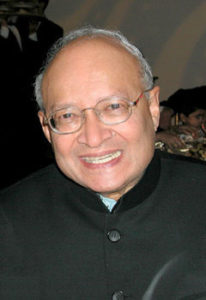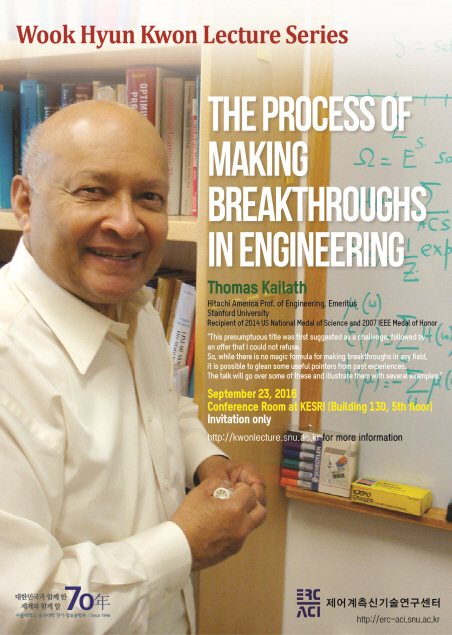Lecture: “The Process of Making Breakthroughs in Engineering”
by Prof. Thomas Kailath
Pre-Lecture: Introduction to Wook Hyun Kwon Lecture Series, Inaugural Congratulatory Address, and Introduction to the speaker
Flyer for the lecture
Date, Time, & Place for this event
Conference Room (5th floor), KESRI (Building 130)
September 23, 2016
Speaker: Thomas Kailath

Thomas Kailath received the BE (Telecom) degree from the College of Engineering, Pune, India in 1956 and MS and ScD degrees from the Massachusetts Institute of Technology in 1959 and 1961. From October 1961 to December 1962, he was at the Digital Communications Division of the Jet Propulsion Laboratory in Pasadena CA, where he also held a visiting appointment at Caltech. He joined Stanford University in January 1963 as an Associate Professor of Electrical Engineering, was promoted to Professor in 1968, and in 1988 was appointed the first holder of the Hitachi America Professorship in Engineering. He assumed emeritus status in 2001, but has been recalled to active duty to continue his research and writing activities.
At Stanford, Kailath served as Director of the Information Systems Laboratory during a decade of rapid growth from 1971 to 1981, and built it into a world-leading center for communications, control and signal processing research. He served on the Executive Committee of the department from 1971 to 1987 and as Associate Chair from 1981 to 1987. He was also twice elected to the Senate of the University.
His research and teaching at Stanford was remarkably wide-ranging. James Gibbons, then Stanford Dean of Engineering, wrote to Kailath on the occasion of his 60 th birthday conference in 1995, “Your career has been an extraordinary success many times over, and for a different set of reasons each decade. I have never seen anything like it in 40 years of service at Stanford”.
Kailath’s research during the 1960s led to prize-winning papers on an algorithm for exploiting the availability of noiseless feedback and new techniques in signal-detection theory. In the 1970s, his work resulted in the influential textbook, Linear Systems (1980), and major contributions to estimation and control resulted in another major textbook, Linear Estimation (2000). In the 1980s, his groups focused on multiple antenna signal processing, the design of VLSI arrays for signal processing, and the development and application of the concept of displacement structure to design fast algorithms for many problems in engineering and mathematics. In the 1990s, they made notable contributions to smart antenna technology for wireless communications and to resolution enhancement techniques for optical lithography in semiconductor manufacturing. Over this period, he also made contributions to stochastic processes, operator theory, and linear algebra.
Kailath’s entry into different fields was aided by his success in attracting a brilliant array of nearly a hundred doctoral and postdoctoral students from around the world, about half of whom are already IEEE Fellows. Their joint efforts have led to over 300 journal papers, a dozen patents, several high-technology companies and a number of books and monographs, including the major textbooks: Linear Systems(1980) and Linear Estimation(2000). For citations over 1980-2000, the ISI (Institute of Scientific Information) list of Highly Cited Authors listed Kailath in three categories: Engineering, Mathematics and Computer Science.
In 2007, then Stanford Dean James Plummer was quoted in a Stanford article on Kailath’s winning the IEEE Medal of Honor as saying: “Many of us have met individuals who have made deep contributions in specific technical fields, or had a major impact on industry, or had a major impact on their academic discipline or educated the leaders of the future. Tom is essentially unique in that he has done all of these things at the very highest level”
He has received many honors over the years, most recently the US National Medal of Science “for transformative contributions to the fields of information and system science, for distinctive and sustained mentoring of young scholars, and for translation of scientific ideas into entrepreneurial ventures that have had a significant impact on industry.”
Among his many other major awards are the IEEE Medal of Honor as well as its Education and Signal Processing Medals; Guggenheim, Churchill and Humboldt Fellowships; Honorary degrees from universities in several countries, most recently from the Technion in Israel; Membership of the National Academy of Engineering, the National Academy of Sciences and the American Academy of Arts and Sciences; Foreign membership of the Royal Society of London, the Royal Spanish Academy, and the four Indian National Science and Engineering Academies; the Padma Bhushan, India’s third highest civilian award: and the 2010 BBVA Foundation Frontiers of Knowledge Award in Information and Communication Technologies.
Photo of the event
See the photo album.

